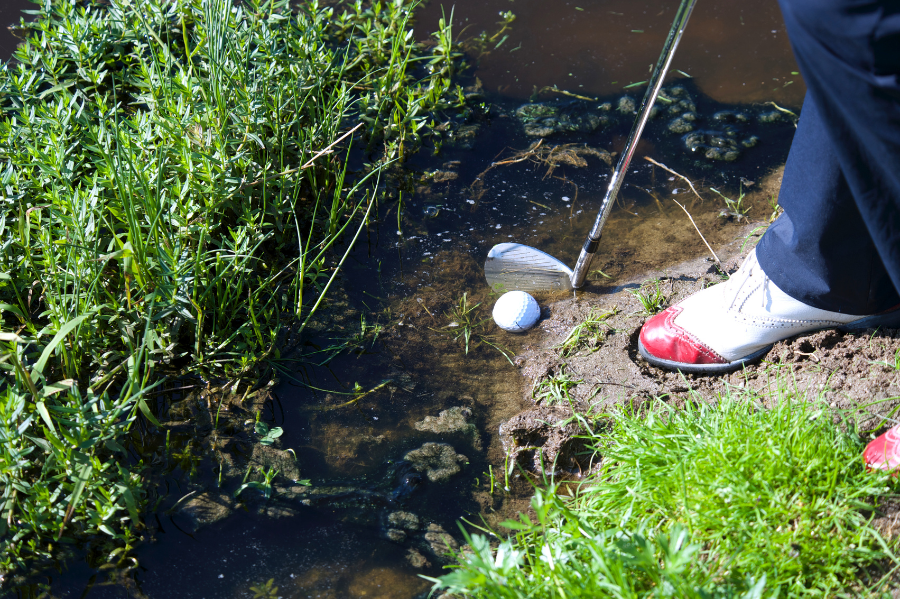Learning how to play golf can be an exciting and fulfilling adventure, particularly for beginners keen to immerse themselves in the sport. This golf guide is meticulously designed to introduce you to the fascinating world of golf in a clear and straightforward way, offering a step-by-step guide that breaks down the game into simple, easy-to-understand segments. As long as you grasp the concepts presented here, you'll establish a solid foundation in the game's essentials, equipping you to step onto the golf course with confidence and a newfound appreciation for this timeless sport.
 Introduction to the world of golf
Introduction to the world of golf
Golf, a sport rich in tradition and history, offers a unique blend of physical activity, mental strategy, and social interaction. Tracing its origins back to 15th-century Scotland, golf has evolved into a globally beloved pastime, accessible to players of all ages and skill levels. At its core, golf involves striking a ball with various clubs, aiming to complete each hole in the fewest strokes possible.
One of its key benefits is the opportunity for gentle yet effective physical exercise, as players walk across expansive, often scenically beautiful courses. Golf also sharpens mental acuity, demanding strategic thinking, focus, and patience. Beyond the physical and mental aspects, golf fosters social connections, providing a platform for relaxed conversation and networking in a serene outdoor setting. This sport transcends mere competition; it's a journey of personal improvement and enjoyment, where each round offers a fresh challenge and a chance to relish nature's tranquility. Whether you're seeking a leisurely pastime, a competitive outlet, or a way to forge new friendships, golf presents a fulfilling and enriching experience.
Golf terms beginners should know
 As a golfer, familiarizing yourself with key terms is crucial for fully engaging in the sport. By mastering golf terms, you'll enhance your comprehension of the game and enrich your overall golfing experience.Here are some essential golf terms for beginners that every beginners should know
As a golfer, familiarizing yourself with key terms is crucial for fully engaging in the sport. By mastering golf terms, you'll enhance your comprehension of the game and enrich your overall golfing experience.Here are some essential golf terms for beginners that every beginners should know
Tee Box: The starting point of any hole where you take your first stroke.
Fairway: The well-maintained area between the tee box and the green, usually the ideal place for your ball to land after the first shot.
Green: The area around the hole, where the grass is cut very short, and where you'll do your putting.
Bunker (or Sand Trap): A hollow area filled with sand, often found near the green or along the fairway, and considered a hazard.
Par: The number of strokes a skilled golfer is expected to make to sink the ball into a specific hole. It varies from hole to hole.
Birdie: Scoring one stroke under par on a hole
Bogey: Scoring one stroke over par on a hole.
Eagle: Scoring two strokes under par on a hole.
Drive: Typically the first shot on a par-4 or par-5 hole, intended to cover a long distance.
Putt: A gentle stroke that rolls the ball across the green towards the hole.
Rough: The taller, often wilder grass that borders the fairway.
Handicap: A numerical measure of a golfer's potential ability, used to enable players of differing abilities to compete against each other.
These terms provide a basic vocabulary for understanding golf's rules and strategies, and their usage can greatly enhance your experience and communication on the course.
A comprehensive overview of golf rules and regulations
For beginners, learning golf rules is fundamental to enjoying and respecting the game. Adhering to the rules ensures that all players can enjoy a respectful and orderly experience on the course. Knowledge of golf rules and regulations is crucial for fair play and for navigating various scenarios that arise during a round.
 Here are the top 10 rules of golf that you should know to ensure fair play and enjoyment on the course
Here are the top 10 rules of golf that you should know to ensure fair play and enjoyment on the course
Play the Ball as It Lies
Always hit your ball from where it lands without moving, touching, or altering its position or the area around it, unless otherwise permitted by specific rules.
Teeing Area Rules
At the start of each hole, you must tee your ball up within the designated teeing area. The ball must be played from behind the tee markers and within two club-lengths behind the markers.
Searching for a Ball
You are allowed a certain amount of time (typically three minutes) to search for a ball. If you can't find it within this time, the ball is considered lost.
Unplayable Lies
If your ball is in a situation where it cannot be played (e.g., stuck in a bush), you are allowed to declare it unplayable, with specific options for proceeding with a penalty.
Out of Bounds and Lost Ball
If your ball is lost or goes out of bounds, you must play another ball from the original spot, taking a penalty stroke.
Water Hazards
Specific rules apply when your ball lands in a water hazard, including options to play the ball as it lies or take a drop with a penalty stroke.
 Bunker Rules
Bunker Rules
When in a bunker, you cannot touch the sand before your shot, and there are restrictions on removing loose impediments.
Putting Green Rules
On the green, you may mark and lift your ball to clean it. You must also ensure the flagstick is either attended, removed, or held up so it does not obstruct your putt.
Order of Play
In stroke play, the player farthest from the hole typically plays first. However, in casual play, "ready golf" (playing when ready) is encouraged to speed up the game.
Penalty Strokes
Understanding when and how penalty strokes are applied - for instance, for a lost ball, water hazard, or unplayable lie—is key to properly navigating the game.
 Mastering golf etiquette 101
Mastering golf etiquette 101
Golf etiquette is a set of unwritten rules and behaviors that guide how players should conduct themselves on the course. It aids in preserving the pristine condition of these courses, ensures safety, accelerates the pace of play, and greatly enhances your respect and reputation within the golfing community. Whether you are playing on any golf course or experiencing Vietnam luxury golf packages, being mindful of these courtesies is crucial. Adhering to this etiquette not only improves the experience for all involved but also honors the distinguished ambiance of these premier golf destinations. These are five rules of golf etiquette you should know to enhances the overall enjoyment of the game for everyone on the course
Respect the Order of Play
It’s important to allow the player furthest from the hole to play first. In "ready golf," a more relaxed approach, players hit when ready, but still in a safe and respectful manner.
Maintain the Pace of Play
Slow play can be frustrating. Be prompt in your actions, be ready to play when it's your turn, and keep up with the group in front of you.
 Care for the Course
Care for the Course
This includes repairing divot holes, smoothing out bunkers after your shot, and fixing ball marks on the green. Respecting the course helps keep it in excellent condition for future players.
Observe Silence and Stillness
Golf etiquette dictates that players should not talk or move during another player's swing. It’s crucial to maintain a quiet environment for players to concentrate, especially when they are taking their shots.
Follow Dress Code and Cell Phone Usage
Most courses have a specific dress code. Adhering to it shows respect for the club’s traditions. Similarly, limit cell phone usage to avoid disturbing others.
Mastering these aspects of golf etiquette not only makes you a more respectful player but also enhances the overall enjoyment of the game for everyone on the course.
 Understanding golf handicaps and how they work
Understanding golf handicaps and how they work
A golf handicap is a numerical measure of a golfer's potential ability based on past performances. It's a vital aspect of the sport, designed to level the playing field, allowing players of varying skill levels to compete fairly against each other.
 How Golf Handicaps are Calculated
How Golf Handicaps are Calculated
Golf handicaps are calculated through a meticulous process that balances a player's performance with the varying difficulties of golf courses. Initially, golfers submit their scores, which are then adjusted for course and weather conditions. Each course is rated with a Course Rating (difficulty for a scratch golfer) and a Slope Rating (relative difficulty for bogey golfers).
A golf handicap calculator is a tool that simplifies this process. Players input their scores along with the course rating and slope rating (measures of a course's difficulty), and the calculator provides an updated handicap index. There are several applications and websites where you can use a free handicap calculator. Popular apps include "The Grint," "Golfshot," and "SwingU." Additionally, "USHandicap" offers an excellent service for calculating accurate handicaps in accordance with USGA regulations. Websites like "MyScorecard" and "GolfLink" are also widely used by golf players.
Golf Handicap Range
The golf handicap range, extending from zero to a maximum of 54.0, encapsulates the broad spectrum of golfing abilities. A zero handicap, or "scratch golfer," indicates the ability to play to a course's par, while elite players might boast a negative handicap, consistently scoring below par. This range reflects the diverse skill levels among golfers, from professionals to novices. The lower your handicap, the more skilled you are considered as a golfer.
Essential Golf Tips for Beginners
Basic Golf Swing Tips
Start with mastering the basics of a golf swing. Ensure your grip is neither too tight nor too loose, maintain a balanced stance, and focus on a smooth, rhythmic swing rather than power. Remember, consistency in your swing is more important than distance.
Left-handed golf tips
If you're left-handed, don't feel left out. The principles of a good golf swing are the same, regardless of which hand is dominant. Ensure you have the right equipment designed for left-handed players, and don't hesitate to seek advice or lessons tailored to left-handed golfers.
 Golf tips for chipping
Golf tips for chipping
Chipping requires finesse and control. Keep your hands ahead of the ball and your weight on your leading foot to ensure a downward strike. Use a putting stroke with your shoulders and arms, and choose the right club for the desired trajectory and roll.
Golf tips to hit a driver
The driver can be one of the most challenging clubs for beginners. Focus on hitting the ball with the center of the clubface. Practice a controlled, even-tempo swing and aim for a higher launch with less spin. Alignment and a relaxed grip are also key.
 Practice Tips
Practice Tips
Practice regularly, but also smartly. Spend time on the driving range, but don't neglect short game areas like chipping and putting. Beginners often see the most improvement by honing these crucial aspects of their game.


